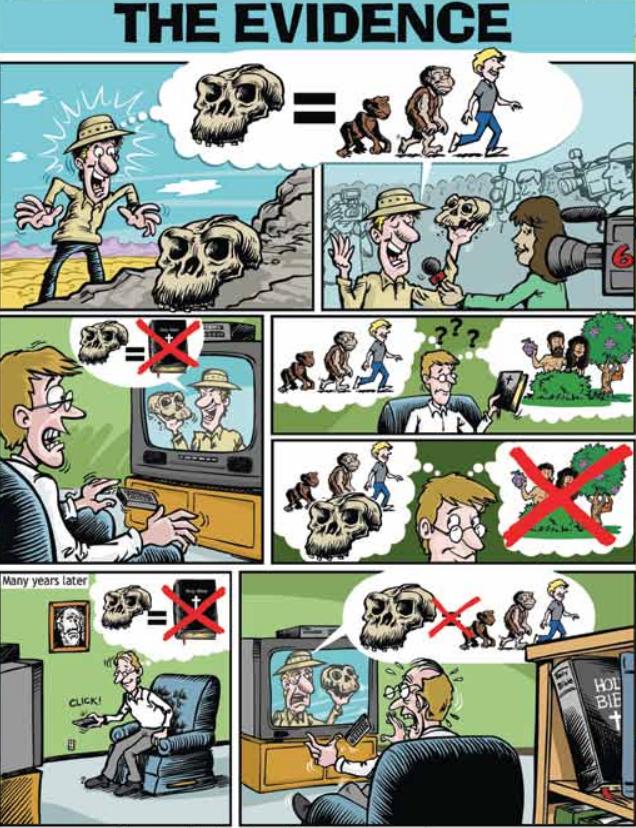Taking a closer look at the evidence
Published in Creation 25(1):36–39, 2002

Every so often, we’ll read in the newspaper, or hear on TV something like, ‘Skull find proves man and apes share a common ancestor.’ But is this really true?
Some background
There are two main (and very different) ideas about the history of our universe.
The first idea comes from the collection of 66 books we call the Bible. In it, God tells us that He created all things in six normal-length days only a few thousand years ago. He explains in Genesis that He created the first man and woman on the sixth day of that first week, along with the various kinds of land animals. (Air and water creatures came the day before, and the various kinds of plants were made on Day 3.) Those who accept this view use the Bible to help them make sense of the world around them.
The second belief is based on the idea that the universe came into being on its own, and that countless millions of years ago a single-celled creature appeared on Earth. This was supposedly our first ancestor, which we share with all living things. Over the years, this creature’s descendants gradually changed into the wide variety of animals and plants that we see today. This view is known as ‘evolution’.
Those who accept this view use evolutionary ideas to help them make sense of the world around them.
Which is right?
Is it possible to know for certain which view of the past is correct? After all, none of us were around ‘in the beginning’, so it’s impossible for us to know firsthand what happened, and when.
However, because the Bible is the written record of One who has always existed and who always tells the truth, we can trust it to be an accurate account of history.
What’s the truth?
So, do headlines, like the one quoted on the previous page, tell the truth? No, since the Bible teaches that the first man was created from the dust of the ground (Genesis 2:7) and the first woman from his rib (Genesis 2:21–24), and both were made in the image of God (Genesis 1:27)—we don’t share a common ancestor with apes.
It’s important to carefully check what was actually found when we hear claims like the one above. Many times, the supposed ‘proof’ of evolution is based on only a few bone fragments, or turns out to be a type of monkey or ape, or a true human—never a ‘transition’ between apes and humans.
The ‘evidence’ (bones, for example) doesn’t prove evolution is true—neither does it ‘prove’ the Bible is true. Rather, we interpret the evidence based on our belief in either evolution or the Bible. When we come across claims that a fossil discovery ‘proves’ evolution we should look more closely at what was really found.

Looking a little closer
Evolutionists claim that humans and apes share a common ancestor that lived millions of years ago.
As evidence, they point to the fossils they’ve uncovered of supposed ‘ape-men’. But the first ‘ape-man’ was described and drawn without any bones having been found; it was based purely on the belief that things made themselves without God (evolution). Bones can be interpreted in many ways. These fossils fit the belief (based on God’s Word) that they are all varieties of true man or extinct apes.
Neandertal man—Neandertal is German for Neander Valley, where bones of this supposed ‘missing link’ were first found about 150 years ago. They were at first drawn as very ape-like, but they are in fact our relatives—descendants of Adam and Eve (through Noah).

Now, pictures and models mostly show them as strikingly human.
Java man—found in East Java over 100 years ago. More skeletons of this type have been found since then. Now that we have more of the bones, it is clear that his body was extremely similar to ours, and he walked just like we do. The same is true for Peking Man, who was discovered in China during the 1920s and ’30s. Both are now called Homo erectus or ‘upright man’. Recent evidence shows that modern-looking early humans had children by both Neandertals and Homo erectus, showing that they are all fully human people groups.
‘Lucy’—‘Lucy’, as the pile of bones found in Ethiopia 20 years ago is known, is among the more famous ‘missing links’. However, careful research on the skull, inner ear and other bones shows that Lucy is very similar to a pygmy chimpanzee. She did not walk upright like humans, but on her knuckles, like gorillas and chimps.
If evolution was true, there should be thousands (if not millions) of fossils showing the transition from ape-like creatures to humans. However, those ‘missing links’ that have been claimed turn out to be nothing more than bones of humans, or bones of some type of extinct ape. Even evolutionists themselves don’t always agree on how the bones should be interpreted! We can’t go wrong if we trust in the Word of God, which never changes and never needs to be updated. It tells us that humans are not evolved animals, but were specially created.


Readers’ comments
Comments are automatically closed 14 days after publication.